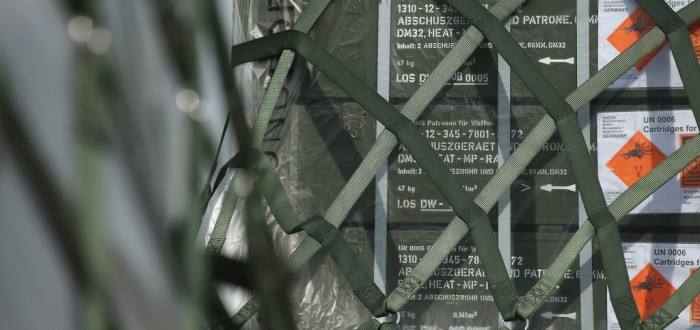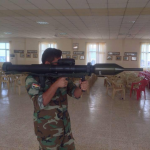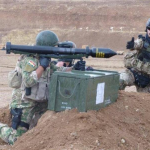N.R. Jenzen-Jones
Photos of arms destined for Kurdish forces being loaded aboard a Royal Dutch Air Force cargo plane in September include several images showing the markings on packaging material. The photo above shows crates containing DM32 multipurpose projectiles for the Panzerfaust 3 (Pzf 3) rocket-assisted recoilless weapon. The Pzf 3 with the DM32 projectile is known as the Bunkerfaust.
The Pzf 3 operates using the recoilless countermass (Davis) principle, resulting in a low-recoil launch of the projectile. Once the projectile is a safe distance from the operator, a rocket motor engages and further accelerates the munition towards its target (from about 150 m/s up to 248 m/s for the DM12/DM12A1; slower for the BKF). Ammunition comes loaded into a disposable launch tube incorporating an iron powder countermass. A common launcher and optical sight unit is used for all ammunition types. The 60 mm launcher fires a projectile with an over-calibre 110 mm warhead, available in the following types:
Pzf 3 EX (DM10) – dummy projectile
Pzf 3 Sub-Kaliber (DM18/DM18A1) 18 mm sub-calibre training device
Pzf 3 UB (DM38) – practice projectile
Pzf 3 UB-T (DM58) – practice projectile with tracer
Pzf 3 (DM12/DM12A1) – high explosive anti-tank rocket-assisted (HEAT-RA)
Pzf 3-T (DM22) – high explosive anti-tank rocket-assisted (HEAT-RA) with tandem charge
Pzf 3-IT (*) high explosive anti-tank rocket-assisted (HEAT-RA) with improved tandem charge
BKF (DM32) – high explosive anti-tank multi-purpose rocket-assisted (HEAT-MP-RA) with tandem charge
The ‘DM’ designations in brackets, above, are German military identifier codes. DM stands for Deutsches Muster, or ‘German pattern’, and indicates the item is to enter production for the German military (in a similar way to a US Army ‘M’ type classification). A Deutsches Truppenversuchs (DT) designation is roughly equivalent to a US ‘XM’ classification, meaning limited troop trials are to be conducted, and a Deutsches Erprobung (DE) designation indicates that testing is underway.
In the case of the Panzerfaust 3 munitions, the first digit indicates the iteration of the munition type adopted in this calibre, whilst the second digit indicates the munition type. An ‘A’ suffix refers to a minor design modification within the type classification (e.g. DM12A1, etc.), whilst a ‘B’ suffix indicates a change in materials but no change in design. In the case of the DM12, for example, the ‘1’ indicates this is the first type of HEAT munition adopted in the 110 mm calibre, whilst the ‘2’ indicates that this is a HEAT projectile. Hence the DM32 Bunkerfaust is the third HEAT projectile to be adopted in the 110 mm calibre.
The Bunkerfaust (BKF) munition is a tandem charge munition, featuring a forward shaped charge intended to penetrate up to 250 mm of masonry, punching a hole through which the HE-FRAG secondary charge can enter the room before detonating. The promotional video below shows the mechanism in action. As the term ‘multi-purpose’ in the designation suggests, the HEAT shaped charge is also effective against light armoured vehicles.
Kurdish forces have been pictured training with the Pzf 3 system, as seen in the images below, but no images of the BKF have yet been seen by ARES. If you have any you wish to share, please contact us. As at 15 October this year, the Bundeswehr had delivered 100 Pzf systems and 200 rounds of ammunition, out of a projected 1,252 systems and 2,500 rounds of ammunition. It is likely that a mixture of HEAT and multi-purpose rounds were supplied.
* Note that the Pzf 3-IT has not yet been adopted by the German military, and so does not have a DM designation.
There is also an AGDUS (Ausbildungsgerät Duellsimulator; ‘battle simulator training device’) version of the Pzf 3 available, however the launcher/optics unit, whilst removable, cannot be used to fire live munitions.
Header image from article as linked. Other images: original source unknown.




